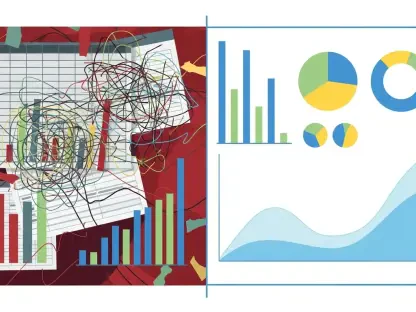In today’s dynamic and often unpredictable business environment, staying ahead of the curve demands more than just short-term fixes—it requires a visionary approach to strategy that anticipates future challenges. Middle-market companies, in particular, face a unique set of obstacles as they grapple with geopolitical tensions, rapid technological advancements, supply chain disruptions, escalating cyber threats, and increasingly stringent regulations, all while operating with fewer resources than industry giants. The pressure to adapt is immense, yet it also presents an opportunity to redefine success by embedding agility and innovation into core operations. This article explores key strategic shifts that can empower businesses to not only weather the storms of uncertainty but to emerge as leaders in a competitive landscape. By focusing on proactive planning and resilience, companies can build a robust framework to thrive amid evolving challenges, ensuring they are prepared for whatever lies ahead.
Harnessing the Power of Industrial AI and Automation
The integration of Artificial Intelligence (AI) and automation stands as a pivotal element in fortifying business strategies for the current era. Far from being mere technological trends, these tools are now fundamental to enhancing productivity and delivering tailored customer experiences. AI-driven solutions can significantly reduce time-to-market by optimizing product development cycles and enabling predictive maintenance, thus preventing costly downtime. Moreover, they facilitate hyper-personalization, allowing businesses to cater to individual customer preferences with precision. Yet, a critical balance must be struck—over-dependence on AI risks eroding the irreplaceable human connection that remains essential in industries such as healthcare and retail travel. Striking this equilibrium means leveraging technology to complement human expertise, ensuring that efficiency gains do not come at the expense of personal engagement or trust.
Another dimension to consider is the emergence of Agentic AI, where autonomous systems independently manage complex workflows with minimal human intervention. This frontier offers immense potential for streamlining operations and driving revenue growth, but it also raises significant concerns around governance and ethical responsibility. Businesses must establish strict frameworks to ensure these systems operate within defined boundaries, maintaining accountability for critical decisions. The challenge lies in determining the extent to which such autonomous tools can be trusted with high-stakes tasks, as missteps could lead to reputational or financial damage. Executives face the task of quantifying the productivity benefits against the risks, ensuring that innovation aligns with long-term strategic goals while safeguarding organizational integrity.
Fortifying Supply Chain Resiliency Against Disruptions
Supply chains have evolved into a critical arena for business stability, especially in light of ongoing geopolitical instability and trade constraints. The traditional focus on cost-cutting is giving way to a more nuanced emphasis on risk management, with strategies like friend-shoring and nearshoring gaining traction as means to diversify and strengthen networks. These approaches prioritize partnerships with geographically or politically aligned regions, reducing exposure to sudden disruptions. Additionally, digital platforms that provide real-time tracking and predictive analytics have become indispensable, offering visibility into potential bottlenecks before they escalate. This proactive stance enables companies to maintain operational continuity, even when faced with unexpected global challenges, by anticipating issues rather than merely reacting to them.
Beyond diversification, the hallmark of a resilient supply chain is its capacity to adapt swiftly under pressure. Whether it involves rerouting production to alternative facilities or securing backup suppliers, the ability to pivot is a defining factor in mitigating losses during crises. Investing in transparency through technology ensures that every link in the chain is accounted for, fostering trust among stakeholders and enhancing responsiveness. Businesses that prioritize such preparedness are better positioned to handle shocks, from natural disasters to policy shifts, without sacrificing efficiency. This strategic focus transforms supply chains from potential liabilities into competitive advantages, providing a buffer against the volatility that characterizes today’s global markets.
Bolstering Cyber Resilience in a Threat-Laden Landscape
As cyber threats grow increasingly sophisticated, often amplified by AI-driven tactics, safeguarding both information technology (IT) and operational technology (OT) systems has become a non-negotiable priority. Cyber resilience transcends traditional defenses like firewalls, encompassing a holistic approach through integrated risk management and the adoption of zero-trust security architectures. These models assume no entity—inside or outside the organization—is inherently trustworthy, thereby minimizing vulnerabilities at every access point. A key metric in this domain is the mean time to recovery, which measures how quickly operations can be restored post-attack. Emphasizing rapid response capabilities ensures minimal downtime, preserving customer trust and financial stability in the face of inevitable breaches.
Equally important is the alignment of cybersecurity with broader organizational objectives, such as environmental, social, and governance (ESG) disclosure requirements. Regulatory bodies are increasingly linking data protection to corporate responsibility, meaning that robust security measures can enhance compliance and reputation simultaneously. Businesses must integrate these considerations into their strategic planning, recognizing that a breach can have far-reaching implications beyond immediate financial loss. By building comprehensive defenses that address both technological and regulatory dimensions, companies not only protect critical assets but also position themselves as trustworthy partners in an era where data integrity is under constant scrutiny.
Navigating Compliance Through Proactive Regulatory Reporting
The labyrinth of global and local regulations, particularly concerning ESG mandates, presents a formidable challenge for businesses in the current climate. Compliance is no longer a mere formality but a strategic differentiator that can bolster corporate reputation and mitigate long-term risks. Proactive regulatory reporting, underpinned by auditable data systems, allows companies to stay ahead of complex mandates, such as climate-risk disclosures. This forward-thinking approach ensures that businesses are not caught off-guard by evolving requirements, instead using compliance as a tool to demonstrate commitment to sustainability and ethical practices. Such transparency can resonate with investors and customers alike, turning a potential burden into a market advantage.
Tailoring compliance systems to accommodate regional variations while maintaining a cohesive global strategy is another critical aspect. Different jurisdictions may impose unique standards, necessitating flexible yet interoperable frameworks to ensure seamless operations across borders. By investing in third-party risk management and robust data infrastructure, businesses can address these disparities without compromising efficiency. Viewing regulatory adherence as an integral part of operations—rather than an external obligation—enables companies to preempt future challenges, reducing the likelihood of penalties or reputational damage. This mindset shift transforms compliance into a proactive investment in stability and trust.
Adapting to Uncertainty with Dynamic Scenario Planning
Economic volatility and regulatory unpredictability demand a flexible approach to financial and strategic planning in today’s business environment. Dynamic scenario planning offers a way to navigate these uncertainties by employing advanced modeling tools to simulate various outcomes and assess potential impacts. This method allows businesses to redefine return-on-investment (ROI) metrics, focusing on long-term value rather than short-term gains. Maintaining liquidity buffers is also crucial, providing the financial cushion needed to weather unexpected downturns or seize emerging opportunities. Such prudence ensures that companies remain agile, capable of adjusting course as conditions evolve without jeopardizing core operations.
Furthermore, the connection between strategic adaptability and investor confidence cannot be overstated. Flexibility in planning often translates into valuation premiums, as stakeholders recognize the reduced risk associated with responsive organizations. By weaving scenario planning into their financial strategies, businesses can craft compelling narratives for investors, highlighting their readiness for diverse market conditions. This approach not only safeguards against economic headwinds but also positions companies as forward-thinking entities capable of leading through instability. Emphasizing agility in this manner reinforces the importance of preparedness as a cornerstone of sustainable growth.
Charting a Path Forward with Strategic Foresight
Reflecting on the journey through today’s business challenges, it becomes evident that middle-market companies tackle unprecedented obstacles with a blend of innovation and resilience. By integrating AI and automation, they enhance operational efficiency while carefully balancing technology with human insight. Supply chain resiliency is fortified through diversified networks and digital transparency, ensuring stability amid global disruptions. Cyber resilience stands as a bulwark against sophisticated threats, aligning security with broader corporate responsibilities. Proactive regulatory reporting turns compliance into a competitive edge, while dynamic scenario planning provides the agility to navigate economic uncertainty. Moving forward, the focus should shift to continuous adaptation—regularly reassessing strategies, investing in emerging technologies, and fostering cross-functional collaboration to anticipate shifts before they materialize. This proactive mindset will be the key to sustaining momentum and securing a lasting advantage in an ever-changing landscape.









